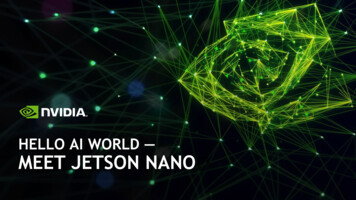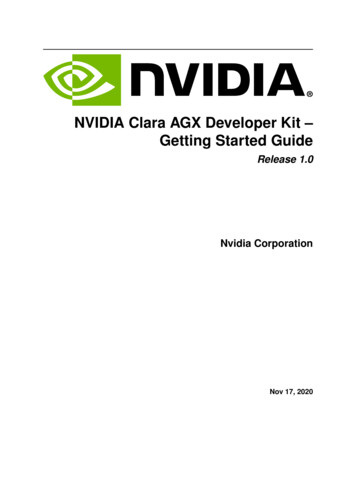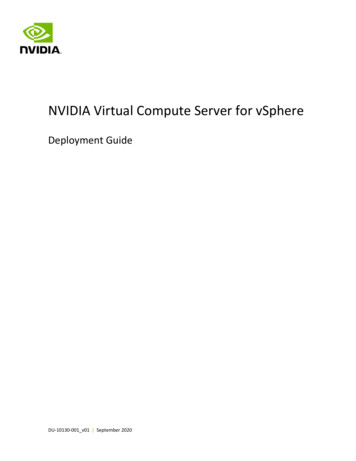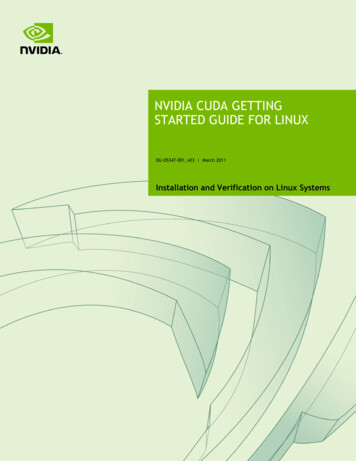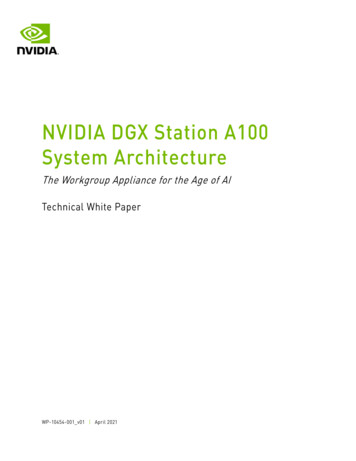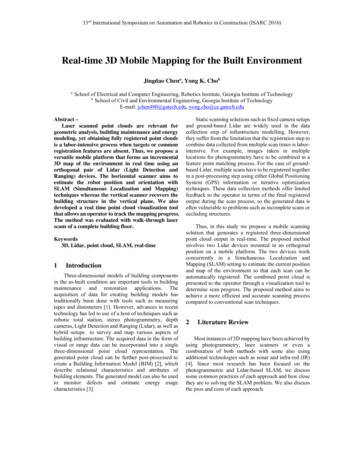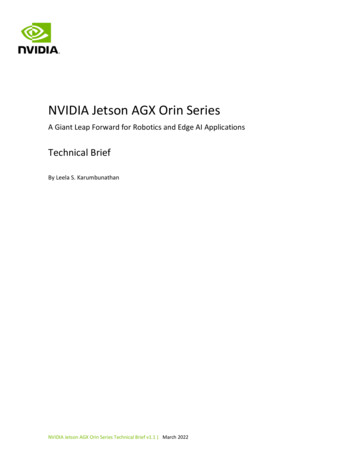
Transcription
NVIDIA Jetson AGX Orin SeriesA Giant Leap Forward for Robotics and Edge AI ApplicationsTechnical BriefBy Leela S. KarumbunathanNVIDIA Jetson AGX Orin Series Technical Brief v1.1 March 2022
Document HistoryTB 10749-001 v1.1VersionDateDescription of Change1.0November 2021Initial Release1.1March 2022Updated with the latest Jetson AGX Orin seriesTable of ContentsIntroduction . 1Jetson AGX Orin Series Hardware Architecture . 2GPU . 53rd Generation Tensor Cores and Sparsity . 5Get the most out of the Ampere GPU using NVIDIA Software Libraries . 6DLA . 7TensorRT supports DLA . 7Giant Leap Forward in Performance . 8CPU . 9Memory & Storage . 10Video Codecs . 10PVA & VIC . 11I/O. 13Power Profiles . 14Jetson Software . 15Jetson AGX Orin Developer Kit . 17NVIDIA Jetson AGX Orin Series Technical Brief v1.1TB 10749-001 v1.1 ii
IntroductionToday’s Autonomous Machines and Edge Computing systems are defined by the growingneeds of AI software. Fixed function devices running simple convolutional neural networks forinferencing tasks like object detection and classification are not able to keep up with new networksthat appear every day: transformers are important for natural language processing for service robots;reinforcement learning can be used for manufacturing robots that operate alongside humans; andautoencoders, long short-term memory (LSTM), and generative adversarial networks (GAN) areneeded for various applications.The NVIDIA Jetson platform is the ideal solution to solve the needs of these complex AIsystems at the edge. The platform includes Jetson modules, which are small form-factor, highperformance computers, the JetPack SDK for end-to-end AI pipeline acceleration, and an ecosystemwith sensors, SDKs, services, and products to speed up development. Jetson is powered by the sameAI software and cloud-native workflows used across other NVIDIA platforms and delivers theperformance and power-efficiency customers need to build software-defined intelligent machines atthe edge. For advanced robotics and other autonomous machines in the fields of manufacturing,logistics, retail, service, agriculture, smart city, and healthcare the Jetson platform is the idealsolution.The newest members of the Jetson Family, the Jetson AGX Orin series, provide a giant leapforward for Robotics and Edge AI. With Jetson AGX Orin modules, customers can now deploy largeand complex models to solve problems such as natural language understanding, 3D perception andmulti-sensor fusion. In this technical brief we identify details on the new architecture of the JetsonAGX Orin series and steps customers can take to leverage the full capabilities of the Jetson platform.NVIDIA Jetson AGX Orin Series Technical Brief v1.1TB 10749-001 v1.1 1
Jetson AGX Orin Series Hardware ArchitectureThe NVIDIA Jetson AGX OrinTM series provides server class performance, delivering up to 275 TOPS ofAI performance for powering autonomous systems. The Jetson AGX Orin series includes the JetsonAGX Orin 64GB and the Jetson AGX Orin 32GB modules. These power-efficient system-on-modules(SOMs) are form-factor and pin-compatible with Jetson AGX XavierTM and offer up to 8X AIperformance. Jetson AGX Orin modules feature the NVIDIA Orin SoC with a NVIDIA Amperearchitecture GPU, Arm Cortex -A78AE CPU, next-generation deep learning and vision accelerators,and a video encoder and a video decoder. High speed IO, 204 GB/s of memory bandwidth, and 32GBor 64GB of DRAM enable these modules to feed multiple concurrent AI application pipelines. Withthe SOM design, NVIDIA has done the heavy lifting of designing around the SoC to provide not onlythe compute and I/O but also the power and memory design. For more details, reference our JetsonAGX Orin Series Data Sheet1.Figure: 1 Jetson AGX Orin delivers 8X the AI performance of Jetson AGX XavierNote: Jetson AGX Orin 64GB Max Performance. Jetson AGX Orin 32GB Performance scales based on the number and frequencies of the CPU, GPU, and DLA.1Jetson AGX Orin Data SheetNVIDIA Jetson AGX Orin Series Technical Brief v1.1TB 10749-001 v1.1 2
Jetson AGX Orin Series Hardware ArchitectureFigure 2: Orin System-on-Chip (SoC) Block DiagramNOTE: Jetson AGX Orin 32GB will have 2x 4 Core Clusters, and 7 TPCs with 14 SMsFigure 3: Jetson AGX Orin Series System-On-ModuleNOTE: One USB 3.2 port, UFS, and MGBE shares UPHY lanes with PCIeNVIDIA Jetson AGX Orin Series Technical Brief v1.1TB 10749-001 v1.1 3
Jetson AGX Orin Series Hardware ArchitectureTable 1: Jetson AGX Orin Series Technical SpecificationsJetson AGX Orin 32GBAI PerformanceGPUMax GPU FreqCPUCPU Max FreqDL AcceleratorDLA MaxFrequencyVisionAcceleratorMemoryStorageCSI CameraVideo EncodeVideo DecodeUPHYNetworkingDisplayOther I/OPowerMechanicalJetson AGX Orin 64GB200 TOPS (INT8)275 TOPS (INT8)NVIDIA Ampere architectureNVIDIA Ampere architecturewith 1792 NVIDIA CUDA cores and 56 with 2048 NVIDIA CUDA cores and 64Tensor CoresTensor Cores939 MHz1.3 GHz8-core Arm Cortex -A78AE v8.2 64-bit 12-core Arm Cortex -A78AE v8.2 64-bitCPUCPU2MB L2 4MB L33MB L2 6MB L32.2 GHz2x NVDLA v2.01.4 GHz1.6 GHzPVA v2.032GB 256-bit LPDDR5204.8 GB/s64GB 256-bit LPDDR5204.8 GB/s64GB eMMC 5.1Up to 6 cameras (16 via virtual channels*)16 lanes MIPI CSI-2D-PHY 2.1 (up to 40Gbps) C-PHY 2.0 (up to 164Gbps)1x 4K60 3x 4K30 6x 1080p60 12x2x 4K60 4x 4K30 8x 1080p60 16x1080p30 (H.265)1080p30 (H.265)H.264, AV1H.264, AV11x 8K30 2x 4K60 4x 4K30 9x1x 8K30 3x 4K60 7x 4K30 11x1080p60 18x 1080p30 (H.265)1080p60 22x 1080p30 (H.265)H.264, VP9, AV1H.264, VP9, AV1Up to 2 x8, 1 x4, 2 x1 (PCIe Gen4, Root Port & Endpoint)3x USB 3.2Single lane UFS1x GbE4x 10GbE1x 8K60 multi-mode DP 1.4a ( MST)/eDP 1.4a/HDMI 2.14x USB 2.04x UART, 3x SPI, 4x I2S, 8x I2C, 2x CAN, DMIC & DSPK, GPIOs15W - 40W15W - 60W100mm x 87mm699-pin Molex Mirror Mezz ConnectorIntegrated Thermal Transfer Plate*Virtual Channel related camera information for Jetson AGX Orin is not final and subject to change.NOTE: Refer to the Software Features section of the latest NVIDIA Jetson Linux Developer Guide for a list of supported featuresNVIDIA Jetson AGX Orin Series Technical Brief v1.1TB 10749-001 v1.1 4
Jetson AGX Orin Series Hardware ArchitectureGPUJetson AGX Orin modules contain an integrated Ampere GPU composed of 2 GraphicProcessing Clusters (GPCs), up to 8 Texture Processing Clusters (TPCs), up to 16 StreamingMultiprocessors (SM’s), 192 KB of L1-cache per SM, and 4 MB of L2 Cache. There are 128 CUDA coresper SM for Ampere compared to the 64 CUDA cores for Volta, and four 3rd Generation Tensor coresper SM. Jetson AGX Orin 64GB has 2048 CUDA cores and 64 Tensor cores with up to 170 Sparse TOPsof INT8 Tensor compute, and up to 5.3 FP32 TFLOPs of CUDA compute. Jetson AGX Orin 32GB has 7TPCs with 1792 CUDA cores and 56 Tensor cores with up to 108 Sparse TOPs of INT8 Tensor compute,and up to 3.37 FP32 TFLOPs of CUDA compute.We have enhanced the Tensor cores with a big leap in performance compared to the previousgeneration. With the Ampere GPU, we bring support for sparsity. Sparsity is a fine-grained computestructure that doubles throughput and reduces memory usage.Figure 4: Orin Ampere GPU Block DiagramNote: The above diagram shows Jetson AGX Orin 64GB. Jetson AGX Orin 32GB will have 7 TPCs and 14 SMs.3rd Generation Tensor Cores and SparsityNVIDIA Tensor cores provide the performance necessary to accelerate next generation AIapplications. Tensor cores are programmable fused matrix-multiply-and-accumulate units thatexecute concurrently alongside the CUDA cores. Tensor cores implement floating point HMMA (HalfPrecision Matrix Multiply and Accumulate) and IMMA (Integer Matrix Multiple and Accumulate)instructions for accelerating dense linear algebra computations, signal processing, and deep learninginference.22NVIDIA Jetson AGX Xavier Developer BlogNVIDIA Jetson AGX Orin Series Technical Brief v1.1TB 10749-001 v1.1 5
Jetson AGX Orin Series Hardware ArchitectureAmpere brings support for the third-generation Tensor cores, which enable support for 16xHMMA, 32x IMMA, and a new sparsity feature.3 With the sparsity feature, customers can takeadvantage of the fine-grained structured sparsity in deep learning networks to double the throughputfor Tensor core operations. Sparsity is constrained to 2 out of every 4 weights being nonzero. Itenables a Tensor core to skip zero values, doubling the throughput and reducing memory storagesignificantly. Networks can be trained first on dense weights, then pruned, and later fine-tuned onsparse weights.Figure 5: Ampere GPU 3rd Generation Tensor Core SparsityGet the most out of the Ampere GPU using NVIDIASoftware LibrariesCustomers can accelerate their inferencing on the GPU using NVIDIA TensorRT and cuDNN.NVIDIA TensorRT is a runtime library and optimizer for deep learning inference that delivers lowerlatency and higher throughput across NVIDIA GPU products. TensorRT enables customers to parse atrained model and maximize the throughput by quantizing models to INT8, optimizing use of the GPUmemory and bandwidth by fusing nodes in a kernel, and selecting the best data layers and algorithmsbased on the target GPU.cuDNN (CUDA Deep Neural Network Library) is a GPU-accelerated library of primitives fordeep neural networks. It provides highly tuned implementations of routines commonly found in DNNapplications like convolution forward and backward, cross-correlation, pooling forward and backward,softmax forward and backward, tensor transformation functions, and more. With the Ampere GPUand NVIDIA software stack, customers are able to handle new, complex neural networks that arebeing invented every er-V1.pdfNVIDIA Jetson AGX Orin Series Technical Brief v1.1TB 10749-001 v1.1 6
Jetson AGX Orin Series Hardware ArchitectureDLAThe NVIDIA Deep Learning Accelerator, or DLA, is a fixed-function accelerator optimized fordeep learning operations. It is designed to do full hardware acceleration of convolutional neuralnetwork inferencing. The Orin SoC brings support for the next generation NVDLA 2.0 with 9X theperformance of NVDLA 1.0.DLA 2.0 provides a highly energy efficient architecture. With this new design, NVIDIAincreased local buffering for even more efficiency and reduced DRAM bandwidth. DLA 2.0 additionallybrings a set of new features including structured sparsity, depth wise convolution, and a hardwarescheduler. This enables up to 105 INT8 Sparse TOPs total on Jetson AGX Orin DLAs compared with11.4 INT8 Dense TOPS total on Jetson AGX Xavier DLAs.Figure 6: Orin Deep Learning Accelerator (DLA) Block DiagramTensorRT supports DLACustomers can use TensorRT to accelerate their models on the DLAs just as they do on the GPU.NVIDIA DLAs are designed for offloading deep learning inferencing from the GPU, enabling the GPU torun more complex networks and dynamic tasks. TensorRT supports running networks in either INT8 orFP16 on DLA, and supports various layers such as convolution, deconvolution, fully connected,activation, pooling, batch normalization, and more. More information on the DLA support in TensorRTcan be found here: Working With DLA4. NVIDIA DLAs enables support for a diversity of models andalgorithms to achieve 3D construction, path planning, semantic understanding, and more. Dependingon what type of compute is needed, both the DLA and the GPU can be used to achieve full applicationacceleration.4Working With DLANVIDIA Jetson AGX Orin Series Technical Brief v1.1TB 10749-001 v1.1 7
Jetson AGX Orin Series Hardware ArchitectureGiant Leap Forward in PerformanceWith GPU and DLA enhancements, the Jetson AGX Orin series provides a giant leap forward inperformance. A new age of robotics is emerging with computational requirements increasing byorders of magnitude for functionality such as multi-sensor perception, mapping and localization, pathplanning and control, situational awareness, and safety.In particular, robotics and other Edge AI applications are requiring increased amounts of AI forcomputer vision and conversational AI. The Jetson AGX Orin module deliver up to 3.3 times theperformance of Jetson AGX Xavier on real world AI applications, as can be seen with our pretrainedmodels. We expect this will increase to an almost 5X performance improvement with future softwareupdates. (Jetson AGX Xavier saw a 1.5X performance increase from when it was launched to now,with the most recent Jetpack software.)Figure 7: Real World AI Performance on Jetson AGX OrinNOTE: These benchmarks were run on the Jetson AGX Orin Developer Kit.NVIDIA Jetson AGX Orin Series Technical Brief v1.1TB 10749-001 v1.1 8
Jetson AGX Orin Series Hardware ArchitectureCPUFor Jetson AGX Orin series modules, we moved from the NVIDIA Carmel CPU to the ArmCortex-A78AE. The Orin CPU complex has up to 12 CPU cores. Each core includes 64KB Instruction L1Cache and 64KB Data Cache, and 256 KB of L2 Cache. Like Jetson AGX Xavier, each cluster also has2MB L3 Cache. The maximum supported CPU frequency 2.2 GHz.Figure 8: Orin CPU Block DiagramNote: The above diagram shows Jetson AGX Orin 64GB. Jetson AGX Orin 32GB will have 2x 4 Core Clusters.The 12-core CPU on Jetson AGX Orin 64GB enables almost 1.9 times the performance compared tothe 8-core NVIDIA Carmel CPU on Jetson AGX Xavier. Customers can use the enhanced capabilities ofthe Cortex-A78AE including the higher performance and enhanced cache to optimize their CPUimplementations.NVIDIA Jetson AGX Orin Series Technical Brief v1.1TB 10749-001 v1.1 9
Jetson AGX Orin Series Hardware ArchitectureMemory & StorageJetson AGX Orin modules bring support for 1.4X the memory bandwidth and 2X the storage ofJetson AGX Xavier, enabling 32GB or 64GB of 256-bit LPDDR5 and 64 GB of eMMC. The DRAMsupports a max clock speed of 3200 MHz, with 6400 Gbps per pin, enabling 204.8 GB/s of memorybandwidth. Figure 8 highlights how each of the various components interact with the MemoryController Fabric and the DRAM.Figure 9: Jetson AGX Orin Series Functional Block DiagramVideo CodecsJetson AGX Orin modules contain a Multi-Standard Video Encoder (NVENC), a Multi-Standard VideoDecoder (NVDEC), and a JPEG processing block (NVJPEG). NVENC enables full hardware accelerationfor various encoding standards including H.265, H.264, and AV1. NVDEC enables full hardwareacceleration for various decoding standards including H.265, H.264, AV1, VP9. NVJPG is responsiblefor JPEG (de)compression calculations (based on the JPEG still image standard), image scaling,decoding (YUV420, YUV422H/V, YUV444, YUV400) and color space conversion (RGB to YUV). Pleasereference the Jetson AGX Orin Data Sheet5for a full list of standards. Customers can leverage NVIDIAJetson’s Multimedia API to power these engines. The Multimedia API6 is a collection of low-level APIsthat supports flexible application development across these engines.56Jetson AGX Orin Data SheetMultimedia APINVIDIA Jetson AGX Orin Series Technical Brief v1.1TB 10749-001 v1.1 10
Jetson AGX Orin Series Hardware ArchitecturePVA & VICJetson AGX Orin modules bring support for our next generation Programmable Vision Acceleratorengine, PVA v2. The PVA engine includes dual 7-way VLIW (Very Long Instruction Word) vectorprocessing units, dual DMA engines, and a Cortex-R5 subsystem. The PVA enables support for variouscomputer vision kernels such as filtering, warping, image pyramid, feature detection, and FFT. Somecommon computer vision applications using the PVA include feature detector, feature tracker, objecttracker, stereo disparity, and visual perception.Figure 10: Orin PVA Block DiagramThe Orin SoC also contains a Gen 4.2 Video Imaging Compositor (VIC) 2D Engine. The VICenables support for various image processing features like lens distortion correction and enhancedtemporal noise reductions, video features like sharpness enhancement, and general pixel processingfeatures like color space conversion, scaling, blend, and composition.Vision Programming Interface (VPI) is a software library which implements computer visionand image processing algorithms on several NVIDIA Jetson hardware components including PVA, VIC,CPU, and GPU. With VPI algorithm support on the PVA and the VIC, one can offload computer visionand image processing tasks to them and prioritize the CPU and the GPU for other tasks.NVIDIA Jetson AGX Orin Series Technical Brief v1.1TB 10749-001 v1.1 11
Jetson AGX Orin Series Hardware ArchitectureAs an example, a complete Stereo Disparity Estimation pipeline using VPI can efficiently use severalbackends including the VIC, PVA, and NVENC. The pipeline receives the input from a stereo camera,which are left and right images of a stereo pair. The VIC works on this input to correct lens distortionand scale the image down, resulting in a rectified stereo pair. Then images get converted from colorto grayscale using the GPU, with the results fed into a sequence of operations using PVA and NVENCas backends. The output is an estimate of the disparity between the input images, which is related tothe scene depth.Figure 11: Stereo Disparity Estimation PipelineVPI comes with several algorithms ranging from image processing building blocks like boxFiltering, Convolution, Image Rescaling and Remap, to more complex computer vision algorithms likeHarris Corners Detection, KLT Feature Tracker, Optical Flow, Background Subtraction, and more.Please check out the VPI Webinars here7 to learn more about using VPI to accelerate computer visionapplications.7VPI WebinarNVIDIA Jetson AGX Orin Series Technical Brief v1.1TB 10749-001 v1.1 12
Jetson AGX Orin Series Hardware ArchitectureI/OJetson AGX Orin series modules contain plenty of high speed I/O including 22 lanes of PCIe Gen4,Gigabit Ethernet, 4 XFI interfaces for 10 Gigabit Ethernet, a Display Port, 16 lanes of MIPI CSI-2,USB3.2 interfaces as well as various other I/O like I2C, I2S, SPI, CAN, GPIO, USB 2.0, DMIC and DSPK.Customers can leverage the UPHY lanes for USB 3.2, UFS, PCIe, and MGBE, and some of the UPHYlanes are shared between these interfaces. All 22 lanes of PCIe support root port mode, and somesupport endpoint mode as well. The Display Port can support 2 displays using the Multi-stream modeon DP1.4. Jetson is used across a variety of applications with various I/O requirements. For example,Autonomous Ground Vehicles could leverage the CSI cameras for a surround view around the robot,I2S for voice commands, HDMI for display, PCIe for Wi-Fi, GPIO & I2C and more. A video analyticsapplication like traffic management at an intersection might require many GigE Cameras and Ethernetfor networking purposes. As autonomous machines continue to perform more advanced tasks, moreI/O is needed to interface more sensors.Table 2: Jetson AGX Orin I/OCSI CameraUPHYNetworkingDisplayOther I/OUp to 6 cameras (16 via virtual channels*)16 lanes MIPI CSI-2D-PHY 1.2 (up to 40Gbps) C-PHY 1.1 (up to 164Gbps)Up to 2 x8 , 1 x4, 2 x1 (PCIe Gen4, Root Port & Endpoint)3x USB 3.2Single-lane UFS1x GbE4x 10GbE1x 8K60 multi-mode DP 1.4a ( MST)/eDP 1.4a/HDMI 2.14x USB 2.04x UART, 3x SPI, 4x I2S, 8x I2C, 2x CAN, DMIC & DSPK, GPIOsNOTE: Refer to the Software Features section of the latest NVIDIA Jetson Linux Developer Guide for a list of supported featureNVIDIA Jetson AGX Orin Series Technical Brief v1.1TB 10749-001 v1.1 13
Jetson AGX Orin Series Hardware ArchitectureIn a survey NVIDIA conducted in March of 2021, when asked what sensors and sensor interfaces arebeing used in your projects, most customers responded that they used cameras via USB, MIPI, andEthernet. Jetson AGX Orin not only enables all these interfaces, but also supports all the other sensorslisted in the survey.Figure 12: Jetson Customer and Developer Survey—Sensor UsagePower ProfilesJetson AGX Orin series modules are designed with a high efficiency Power Management IntegratedCircuit (PMIC), voltage regulators, and power tree to optimize power efficiency. Jetson AGX Orin 64GBsupports three optimized power budgets: 15W, 30W, and 50W. Each power mode caps variouscomponent frequencies, and the number of online CPU, GPU TPC, DLA, and PVA cores. Jetson AGXOrin 64GB also supports a MAXN performance mode that can enable up to 60W of performance.Jetson AGX Orin 32GB supports power modes between 15W and 40W. Customers can leverage thenvpmodel tool in Jetson Linux to use one of these pre-optimized power modes or to customize theirown power mode within the design constraints provided in our documentation.NVIDIA Jetson AGX Orin Series Technical Brief v1.1TB 10749-001 v1.1 14
Jetson SoftwareJetson SoftwareThe Jetson platform includes all the necessary software to accelerate your development andget your product quickly to market. At the base of the software stack is the JetPack SDK. It includesthe Board Support Package (BSP), with boot loader, Linux kernel, drivers, tool chains and a referencefile system based on Ubuntu. The BSP also enables various security features such as secureboot,trusted execution environment, disk and memory encryption and so on. Over the BSP we haveseveral user level libraries for accelerating various parts of your application. These include libraries foraccelerating deep learning like CUDA, CuDNN, and Tensor RT; accelerated computing libraries likecuBLAS and cuFTT; accelerated computer vision and image processing libraries like VPI; andmultimedia and camera libraries like libArgus and v4l2.On top of JetPack there are higher level, use case specific SDKs including DeepStream forIntelligent Video Analytics applications, Isaac for Robotics applications, and Riva for Natural LanguageProcessing applications. Surrounding this NVIDIA has a growing partner ecosystem that can providecustomers with specialty products and services to accelerate development.AI at the edge is growing, and the complexity of edge deployment is growing. We see variouschallenges arising from creating AI products. You need lots of data to train accurately, and you needyour models to be optimized for inference. High Performance models from open-source options donot provide desirable results nor are optimized for highest inference throughput. There is also a needto support various frameworks, and a deep understanding of Deep Learning and Data Science.NVIDIA’s TAO Toolkit and Pre-Trained Models (PTM) can help solve this challenge. NVIDIA pre-trainedmodels provide customers with accurate models that have been pre-trained with millions of imagesto achieve state of the art accuracy out of the box. The pre-trained model library can be found here8,and includes various PTMs like people detection, vehicle detection, natural language processing, poseestimation, license plate detection, and face detection. TAO toolkit enables customers with the abilityto easily train, fine-tune, and optimize these pretrained models with their own data set. Customerscan then easily deploy these models in production using our various inference SDKs.Edge computing has historically been characterized by systems that rarely get softwareupdates. With new cloud technologies, you need to be able to periodically update the software onyour deployed products, and have the flexibility to adopt, and easily scale and deploy across variousenvironments. Jetson brings Cloud-Native to the edge and enables technologies like containers andcontainer orchestration. NVIDIA JetPack includes NVIDIA Container Runtime with Docker integration,enabling GPU accelerated containerized applications on Jetson platform. Jetpack also brings supportfor NVIDIA Triton Inference Server to simplify the deployment of AI models at scale. Triton InferenceServer is open source and provides a single standardized inference platform that can support multi8TAO Toolkit NVIDIA DeveloperNVIDIA Jetson AGX Orin Series Technical Brief v1.1TB 10749-001 v1.1 15
Jetson Softwareframework model inferencing in different deployments such as datacenter, cloud and embeddeddevices. It supports different types of inference queries through advanced batching and schedulingalgorithms to maximize performance of your AI application and supports live model updates with zeroinferencing downtime.Figure 13: Jetson Cloud Native Software StackJetPack 5.0 provides the software to power the Jetson AGX Orin and future Jetson modules,as well as existing Jetson modules based on the NVIDIA Xavier SoC. Jetpack 5.0 includes L4T with Linuxkernel 5.10 and a reference file system based on Ubuntu 20.04. Jetpack 5.0 enables a full computestack update with CUDA 11.x and new versions of cuDNN and Tensor RT. It will include UEFI as a CPUbootloader and will also bring support for OP-TEE as a trusted execution environment. Finally, therewill be an update to DLA support for NVDLA 2.0, as well as a VPI update to support the nextgeneration PVA v2.NVIDIA Jetson AGX Orin Series Technical Brief v1.1TB 10749-001 v1.1 16
Jetson AGX Orin Developer KitJetson AGX Orin Developer KitThe Jetson AGX Orin Developer Kit will contain everything needed for developers to get upand running quickly. The Jetson AGX Orin Developer Kit includes a Jetson AGX Orin module withheatsink, a reference carrier board, and a power supply. The Jetson AGX Orin Developer kit can beused to develop for all the Jetson Orin modules via emulation modes to emulate their performance.With up to 275 TOPS of AI performance and power configurable between 15 and 60 W, customersnow have more than 8X the performance of Jetson AGX Xavier in the same compact form-factor fordeveloping advanced robots and other autonomous machine products.The Jetson AGX Orin Developer Kit is available today.Figure 13: Jetson AGX Orin Developer KitNVIDIA Jetson AGX Orin Series Technical Brief v1.1TB 10749-001 v1.1 17
Jetson AGX Orin Developer KitTable 3: Jetson AGX Orin Developer Kit Technical SpecificationsMODULE:GPUCPUDL AcceleratorVision AcceleratorMemoryStoragePowerNVIDIA Ampere architecture with 2048 NVIDIA CUDA cores and 64 Tensor cores12-core Arm Cortex-A78AE v8.2 64-bit CPU3MB L2 6MB L32x NVDLA v2.0PVA v2.032GB 256-bit LPDDR5204.8 GB/s64GB eMMC 5.115W to 60WREFERENCE CARRIER BOARD:Camera16 lane MIPI CSI-2 connectorPCIex16 PCIe slot supportingx8 PCIe Gen4M.2 Key Mx4 PCIe Gen 4M.2 Key Ex1 PCIe Gen 4, USB 2.0, UART, I2SUSBType C: 2x USB 3.2 Gen2 with USB-PD supportType A: 2x USB 3.2 Gen2, 2x USB 3.2 Gen1Micro-B: USB 2.0NetworkingRJ45 (up to 10 GbE)DisplayDisplayPort 1.4a ( MST)microSD slotUHS-1 cards up to SDR104 modeOthers40-pin header (I2C, GPIO, SPI, CAN, I2S, UART, DMIC)12-pin automation header10-pin audio panel header10-pin JTAG header4-pin fan header2-pin RTC battery backup connectorDC power jackPower, Force Recovery, and Reset buttonsDimensions110mm x 110mm x 71.65mm(Height includes feet, carrier board, module, and thermalsolution)NVIDIA Jetson AGX Orin Series Technical Brief v1.1TB 10749-001 v1.1 18
NoticeThe information provided in this specification is believed to be accurate and reliable as of the date provided. However, NVIDIA Corporation (“NVIDIA”) does not giveany representations or warranties, expressed or implied, as to the accuracy or completeness of such information. NVIDIA shall have no liability for the consequencesor use of such information or for any infringement of patents or other rights of third parties that may result from its use. This publication supersedes and replaces allother specifications for the product that may have been previously supplied.NVIDIA reserves the right to make corrections, modifications, enhancements, improvements, and other changes to this specification, at any time and/or todiscontinue any product or service without notice. Customer should obtain the latest relevant specification before placing orders and should verify that suchinformation is current and complete.NVIDIA products are sold subject to the NVIDIA standard terms and conditions of sale supplied at the time of order acknowledgement, unless otherwise agreed in anindividual sales agreement signed by authorized representatives of NVIDIA and customer. NVIDIA hereby expressly obj
and complex models to solve problems such as natural language understanding, 3D perception and . Note: The above diagram shows Jetson AGX Orin 64GB. Jetson AGX Orin 32GB will have 7 TPCs and 14 SMs. . (CUDA Deep Neural Network Library) is a GPU-accelerated library of primitives for
